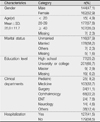Abstract
Purpose
The purpose of this study was to examine the effect of patient perception of the switching cost and negative word of mouth on revisit intention of patients in out-patient departments (OPDs) of general hospitals.
Methods
The participants were 306 patients in general hospital, selected through convenience sampling. Data were collected using a structured questionnaire and analyzed using descriptive statistics, Spearman correlation coefficient, and logistic regression with SPSS Win.
Results
Relational switching cost was positively correlated with revisit intention (r=.58, p=<.001), but not financial switching cost or procedural switching cost. Negative word of mouth was negatively correlated with revisit intention (r=-.22, p=<.001). The significant predictors influencing revisit intention in patients was relational switching cost.
Figures and Tables
References
1. Anderson E, Sullivan MW. The Antecedents and consequences of customer satisfaction for firms. Mark Sci. 1993. 12(2):125–143.

2. Burnham TA, Frels JK, Mahajan V. Consumer switching costs: A typology, antecedents, and consequences. J Acad Mark Sci. 2003. 31(2):109–126.

3. Chen PY, Hitt LM. Measuring switching costs and the determinants. of customer retention in internet-enabled businesses: A study of the online brokerage industry. Inf Syst Res. 2002. 13(3):255–274.

4. Jackson BB. Winning and keeping industrial customers. 1985. MA: Lexington Books.
5. Jones MA, Mothersbaugh DL, Betty SE. Switching barriers and repurchase intentions in services. J Retail. 2000. 76(2):259–274.

6. Jones MA, Reynolds KE, Mothersbaugh DL, Beatty SE. The positive and negative effects of switching costs on relational outcomes. Inf Syst Res. 2007. 9(4):335–355.

7. Jung IK, Park CJ. A Study of the effects of the customer value and switching barriers on the repurchase intention in internet shopping malls. J MIS Res. 2004. 14(1):185–209.
8. Jung Y. Developing customer switching costs model and measuring the effects of switching costs. 2007. Seoul, Korea: Yonsei University;Unpublished master's thesis.
9. Kim SH, Oh SH. The determinants of repurchase intentions in the service industry: customer value, customer satisfaction, switching costs, and attractiveness of alternatives. Korean Mark Rev. 2002. 17(2):25–55.
10. Ko SD. The effect of switching cost and customer satisfaction on repurchasing intention in the food service industry. Tourism Res. 2002. 16:113–139.
11. Kolter P. Marketing management: analysis, planning, and control. 1990. N.J.: Prentice-Hall Inc.;135. 602.
12. Lee YJ, Lee CL. Antecedents and consequences of switching costs: The moderating role of service subscription types. Korean Mark Rev. 2005. 20(3):1–28.
13. Lee JH. How do multidimensional switching costs affect customer commitment? 2007. Seoul: Yonsei University;Unpublished master's thesis.
14. Lee JS, Choi SH. Relation between negative word-of-mouth communication on choice of restaurant and purchasing behavior in the customer of food service. J Tourism Leis Res. 2002. 13(2):9–24.
15. Lee SH, Moon HY, Oh SY. Effects of customer badness behavior intention on negative word of mouth and revisit intention in restaurants: Focus on the gender and the partner type. J Foodserv Manage. 2009. 12(3):257–275.
16. Lee YJ, Gong TS. The effects of service justice on customer badness behavior-mediating roles of negative affectivity and customer commitment. Korean Mark Rev. 2004. 19(4):185–210.
17. Lim S. Why get a special hospital an eye to model enterprise? Medicalobserver. 2008. 05.
http://www.medicalobserver.co.kr/News/news_view.aspx?Cid=H0301&Cno=25843&Pno=20.
18. Min EH. A study on the relationship repurchase and nonrelational repurchase. 2002. Seoul, Korea: Dankook University;Unpublished doctoral dissertation.
19. Morgan RM, Hunt SD. The commitment-trust theory of relationship marketing. J Mark. 1994. 07. 58:20–38.

20. Porter ME. Competitive strategy. 1980. New York: Free Press.
21. Reichheld FF. Learning from customer defections. Harv Bus Rev. 1996. March/April. 56–69.
22. Reichheld FF, Sasser WE. Zero Defections: Quality comes to services. Harv Bus Rev. 1990. 68(5):105–111.
23. Sharma N. The role of pure and quasi-moderators in services: An empirical investigation of ongoing customer-service provider relationships. J Retail Consum Serv. 2003. 10(4):253–262.

24. Son YM. Effect of Relationship Marketing Implement Factors on the Customer Trust, Customer Loyalty, and Repurchase in Hospital. 2004. Pusan, Korea: Kosin University;Unpublished doctoral dissertation.
25. Yu HK, Lee JH. The effect of transaction characteristics and switching costs on behavioral intentions of food service entrepreneurs for tax service. Tourism Res. 2009. 24(3):63–84.




 PDF
PDF ePub
ePub Citation
Citation Print
Print






 XML Download
XML Download